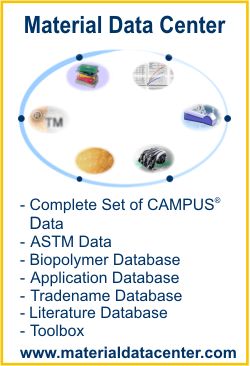Material Data Center is a leading international information system for the plastics industry. Material Data Center offers a comprehensive plastics database, calculation tools, CAE interfaces, a literature database and an application database. For more information about Material Data Center visit www.materialdatacenter.com.
This is the free Material Data Center Datasheet of Amphora™ Flex 3D Polymer FL6000 - Polyester - Eastman Chemical Co.
unit conversion, PDF datasheet print, comparison with other plastics
Check here, which other Amphora datasheets, application examples or technical articles are available in Material Data Center
Application/Uses
-Production of 3D Printing Filaments
Eastman Amphora™ Flex 3D polymer FL6000, a flexible material uniquely engineered for extrusion-based additive
manufacturing processes. Amphora Flex FL6000 is a polymer that can be used with standard 3D printers—
eliminating the need to switch to specialized flex extruders. Thanks to exceptional layer-to-layer adhesion and
melt strength, it prints at a faster speed than other elastomeric materials, saving you time. Amphora Flex FL6000
is an engineering-grade material that demonstrates superior durability and toughness, enabling designers to
quickly create truly functional parts that can withstand the rigors of everyday use. Amphora Flex FL6000 is highly
useful for applications that demand both the durability of an engineering-grade polymer and the comfort and
utility of a flexible material. With a Shore A hardness level of 95, outstanding chemical resistance, and a
temperature resistance that allows steam sterilization, users may find it to be the ideal polymer for additive
manufacturing of prosthetics, orthotics, automotive parts, apparel, tooling, or a variety of consumer products.
| Mechanical properties | Value | Unit | Test Standard | ||||||||||||||||||||||||||||||||||||||||||||||||||||||||||||||||||||||||||||||||||||||||||||||||
| ASTM Data | |||||||||||||||||||||||||||||||||||||||||||||||||||||||||||||||||||||||||||||||||||||||||||||||||||
| Tensile Strength at Yield | 14 | MPa | ASTM D 638 | ||||||||||||||||||||||||||||||||||||||||||||||||||||||||||||||||||||||||||||||||||||||||||||||||
| Tensile Strength at Break | 22 | MPa | ASTM D 638 | ||||||||||||||||||||||||||||||||||||||||||||||||||||||||||||||||||||||||||||||||||||||||||||||||
| Elongation at Yield | 38 | % | ASTM D 638 | ||||||||||||||||||||||||||||||||||||||||||||||||||||||||||||||||||||||||||||||||||||||||||||||||
| Elongation at Break | 400 | % | ASTM D 638 | ||||||||||||||||||||||||||||||||||||||||||||||||||||||||||||||||||||||||||||||||||||||||||||||||
| Flexural Modulus | 150 | MPa | ASTM D 790 | ||||||||||||||||||||||||||||||||||||||||||||||||||||||||||||||||||||||||||||||||||||||||||||||||
| Shore A Hardness | 95 | - | ASTM D 2240 | ||||||||||||||||||||||||||||||||||||||||||||||||||||||||||||||||||||||||||||||||||||||||||||||||
| Shore D Hardness | 55 | - | ASTM D 2240 | ||||||||||||||||||||||||||||||||||||||||||||||||||||||||||||||||||||||||||||||||||||||||||||||||
| Izod Impact notched, Low-Temperature | 40 | J/m | ASTM D 256 | ||||||||||||||||||||||||||||||||||||||||||||||||||||||||||||||||||||||||||||||||||||||||||||||||
| Temperature | -40 | °C | - | ||||||||||||||||||||||||||||||||||||||||||||||||||||||||||||||||||||||||||||||||||||||||||||||||
| Thermal properties | Value | Unit | Test Standard | ||||||||||||||||||||||||||||||||||||||||||||||||||||||||||||||||||||||||||||||||||||||||||||||||
| ASTM Data | |||||||||||||||||||||||||||||||||||||||||||||||||||||||||||||||||||||||||||||||||||||||||||||||||||
| Vicat Temperature | 170 | °C | ASTM D 1525 | ||||||||||||||||||||||||||||||||||||||||||||||||||||||||||||||||||||||||||||||||||||||||||||||||
| Other properties | Value | Unit | Test Standard |
| Density | 1130 | kg/m³ | ASTM D 792 |
| Processing Recommendation Extrusion | Value | Unit | Test Standard |
| Melt temperature | 240 - 260 | °C | - |
Material Data Center is provided by M-Base Engineering + Software GmbH. M-Base Engineering + Software GmbH assumes no liability for the system to be free of errors. Any decision about the application of materials must be double checked with the producer of this material.
Additional information about this material, like producer contact address, etc. can be found at www.materialdatacenter.com. For access to this extra information a registration is requested. Free online registration is available.













